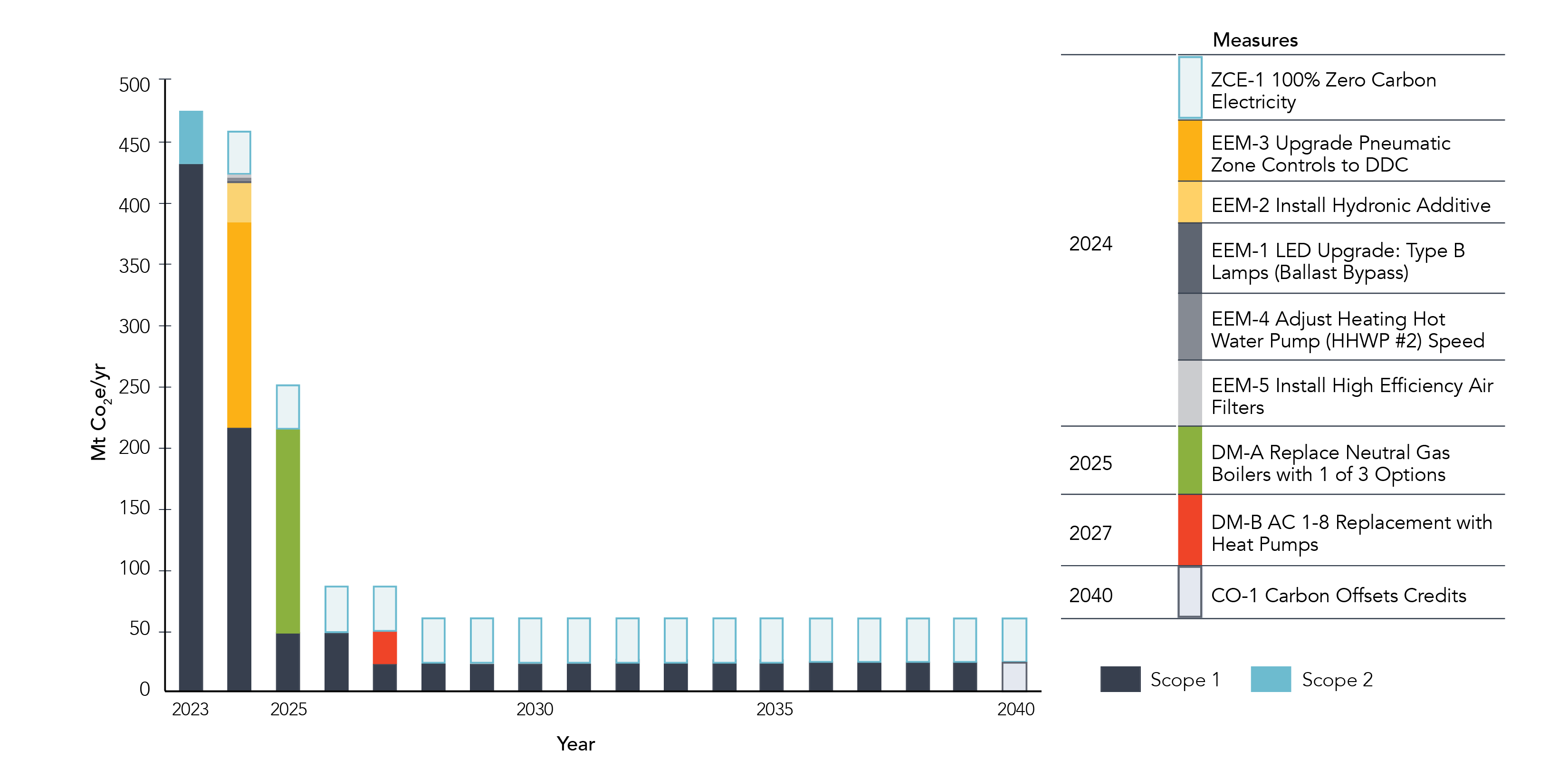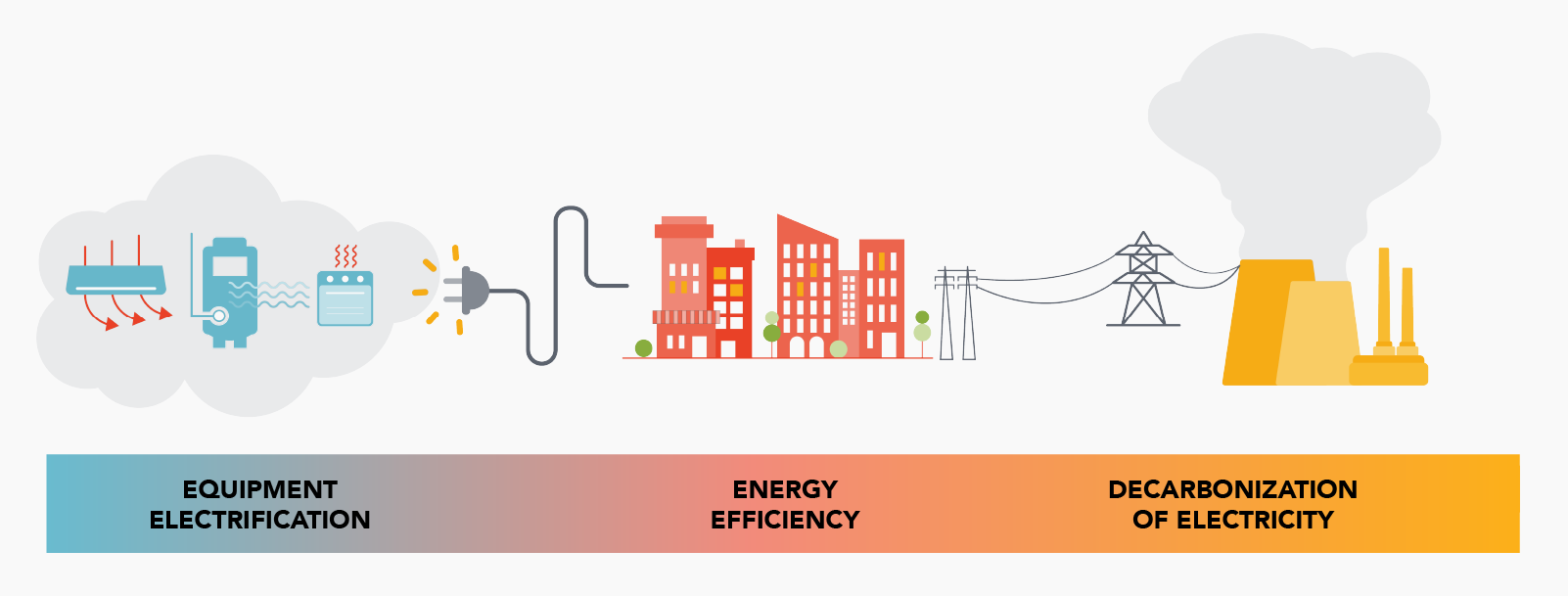Written by: Samantha Fung, CEM, LEED GA, BREEAM AP | Director, Decarbonization
What is a decarbonization roadmap?
A decarbonization roadmap serves as a plan to reduce a building’s operational carbon footprint over time. The process begins by defining a carbon emissions baseline developed from the operational energy use and associated carbon emissions of a building in alignment with the greenhouse gas protocol. Next an ASHRAE level 2+ energy audit is completed onsite to determine the current building performance. The audit provides decarbonization measures including rough order of magnitude implementation cost and basic financial metrics such as simple payback, energy and carbon savings. Building off of the carbon footprint, the measures are arranged over time to reduce the operational emissions of the building and to meet internal or regulatory targets.

The measures can be categorized into three strategies:
- Energy efficiency includes measures that reduce energy and therefore reduce carbon emissions.
- Decarbonization of electricity is using a renewable electricity source that has zero carbon emissions associated with it such as green power from solar or wind generation.
- Electrification entails switching to a fuel type that can have zero carbon emissions, such as the switch from natural gas to electricity.

Why develop a decarbonization roadmap?
A decarbonization roadmap empowers owners and managers to align their buildings with internal greenhouse gas (GHG) emission targets, external regulatory requirements and to proactively plan for decarbonization measures over time. Here are 5 reasons to develop a decarbonization strategy:
- Internal emission targets. With sixty percent of Fortune 500 companies having set goals to act on the climate crisis and address energy use, in 2021, there is a need to align buildings with these targets.[1] A roadmap will determine a path the individual dual building needs to take to contribute towards the organization’s overall targets.
- External regulatory requirements and GHG compliance- The upcoming U.S. Securities and Exchange Commission (SEC) emission disclosure requirements for companies and the commercial building reporting requirements of various states and cities will provide an incentive to reduce the building emissions. Leading Edge provides a legal and regulatory compliance scan in the decarbonization roadmap to keep owners in front of current and upcoming requirements.
- End of life- The end of useful life of major energy consuming equipment provides a great opportunity to plan ahead and evaluate fuel switching options, advanced energy efficient solutions and systems that use low/no global warming potential (GWP) refrigerant. Decarbonization roadmaps highlight each of these opportunities to reduce emissions over the targeted period.
- Safety, ongoing maintenance, occupant comfort– Sometimes measures do not pencil out when considering their ability to save energy alone, even with rebates and incentives. Working closely with the property management teams and building engineers will underscore additional considerations regarding safety concerns, ongoing maintenance issues and occupant comfort. These reasons can often be more compelling than the financial story alone, especially in a highly competitive leasing market.
- Budget ahead– Having a roadmap in place will allow the property management team to anticipate capital projects and plan ahead to find the right partners such as designers or contractors to perform the work after going out to bid.
Why Leading Edge?
Whether developing a pathway for a single asset, fund or full portfolio, Leading Edge takes on a thorough, real-world approach to establishing carbon profiles, assessing building performance and incorporating future factors that will inevitably impact the financial case for establishing targets. Our decarbonization team is comprised of engineers, carbon accountants, and property management veterans who have direct experience and an understanding of the complexity of building operations. We recognize each client’s unique approach to real estate ownership, investment, management, and develop bespoke strategies to reach their decarbonization goals. Since 2008, Leading Edge has supported client’s sustainability efforts in the built environment.
Have questions? Please feel free to reach out to us.
